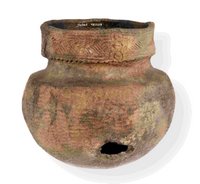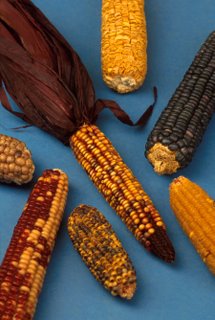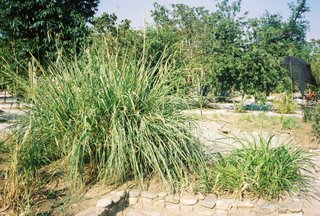 Jacques Cartier, the famous French explorer, made 3 trips to Canadian shores between 1534 and 1542. Each time he encountered native people and saw their settlements. During his last two voyages he came to interact with the Iroquoian people along the shores of the St. Lawrence, and left detailed accounts of those encounters.
Jacques Cartier, the famous French explorer, made 3 trips to Canadian shores between 1534 and 1542. Each time he encountered native people and saw their settlements. During his last two voyages he came to interact with the Iroquoian people along the shores of the St. Lawrence, and left detailed accounts of those encounters.About 60 years later, when Samuel de Champlain of France also sailed up the St. Lawrence in 1603, he saw no Indian villages along his route. What had happened? Why have the Iroquoian people disappeared from the region?
The new exhibition at the Montreal Museum of Archaeology and History Pointe-à-Callière In Search of a Missing People addresses this issue. Although it has been considered that the white men’s diseases might have devastated the native population, the evidence suggests otherwise. First, the Iroquoian population was still intact between Cartier’s voyages; and second, the settlements had already started to disappear before Cartier’s first arrival at the St. Lawrence region. This process started in the west, in what is presently Ontario (where Cartier never set foot) and continued in a domino-like effect towards the east.
It is now assumed that the settlements were wiped out by the ongoing war between the different groups. Cartier had noted that each village was heavily protected by several tiers of palisades with watch platforms in the upper tier. In addition, the arrival of the Europeans might have destabilized the precarious power-struggle equilibrium between the groups, even creating jalousies because of iron tools and decorative beats acquired from the whites.
It is speculated that the Iroquoian people did not disappear completely, but were rather absorbed and integrated into other Indian tribes.
So what made St. Lawrence Iroquoian Indians unique?
 Contrary to Algonquian Indians who were nomads, Iroquoian Indians, thanks to corn cultivation, no longer had to fallow the migration of game. They began building year round permanent settlements, and acquired characteristics of an agricultural society.
Contrary to Algonquian Indians who were nomads, Iroquoian Indians, thanks to corn cultivation, no longer had to fallow the migration of game. They began building year round permanent settlements, and acquired characteristics of an agricultural society.Corn was adaptated by the St Lawrence Iroquoians between 800-1200 AD. This was a culmination of corn’s long journey from Mexico. A variety of corn widely used was Northern Flint that has some or all purple kernels. It contains little moisture and becomes very hard and shiny when dry. It is still used today especially during Native ceremonies. You can buy a sachet of Northern Flint kernels for $2 at the Museum, and can even start growing this corn yourself!
Corn (maize) was a result of a very rare mutation in a wild spiked grass called Teosinte (see Photo 3 below) which had only about 10 inedible kernels. 7,000 years ago people gathered Teosinte for its sweet chalks. They ate the pith, and ferment it to make alcohol. They also ate unripe cobs. The Teosinte mutation took place about 5,500 years ago, and today’s corn cobs are much longer and thicker and have a lot more kernels.
 It was a woman’s job to cultivate corn. They planted it in small round patches together with two other crops, and called this triad “Three Sisters”. The beans would wind around corn stacks and deliver nitrogen to the soil, so no fertilization was needed, and the squashes’ wide leaves preserved the ground moisture, so it did not need to be watered.
It was a woman’s job to cultivate corn. They planted it in small round patches together with two other crops, and called this triad “Three Sisters”. The beans would wind around corn stacks and deliver nitrogen to the soil, so no fertilization was needed, and the squashes’ wide leaves preserved the ground moisture, so it did not need to be watered.One of the staples of Iroquoian diet was a soup called sagamite: a handful of flour, dried fish, meat, beans, and squash. Women also baked pumpkins and squash in embers, and made carraconny or corn loafs, by setting them on a broad flat stone and covering them with hot pebbles.
Iroquoian women handled all the work of growing food, including sowing, tending, harvesting and drying the crops They made corn flour, gathered and carried firewood, water, fruit, and nuts. They made ropes, nets, mats, baskets, ceramic pots, and farming tools. They hunted small game, fished, made garments, and put the finishing touches to snowshoes and canoes. And, of course, they were also wives and mothers.
Women were the prime movers in domestic life, and this kept them tied down to the villages. Even the social structure revolved around some of the women, the “clan mothers”. An Iroquoian house was a woman’s place. A man came to live with a woman. Iroquoian society was matrilineal - the family line was passed down from mother to daughter rather than from father to son. It was also matrilocal – a married couple lived with the wife’s family, flanked by families of daughters and grand daughters, with their husbands and children. These lineages in turn formed clans that were led by a clan mother.
A village civil chief - always a man - was chosen by women elders. They also revoked the chief’s powers if needed.
But men chose the war chief. Besides going to wars and organizing big game hunting expeditions, men also cleared land from trees and build longhouses, protective palisades and canoes.
The present exhibition at the Museum will immerse you in the everyday life of the Iroquoian people. You will also see many Iroquoian pottery pieces, as well as pipes, ornaments, and other items such as those used in game playing and gambling. You will also see the very first map of various Iroquoian settlements along the St Lawrence River. And, of course, you will learn a lot about our collective history.
Where: Montreal Museum of Archaeology and History Pointe-à-Callière
350 Place Royal,
Montreal, QC H2X 3Y5
Canada
When: November 7, 2006 – May 6, 2007
Museum’s Website:
http://www.pacmuseum.qc.ca
Photo 1
Iroquoian Vase
Montreal Museum of Archaeology and History Pointe-à-Callière
Photo 2
Multicolored corn
By Keith Weller This is a file from the Wikimedia Commons
Photo 3
Two plants believed to be of the species hybridized to create maize. Jardín Etnobotánico (Ethnobotanical Garden), Oxaca, Mexico, June 2005.
Cc-by JerryFriedman 21:26, 27 March 2006 (UTC)
This is a file from the Wikimedia Commons
No comments:
Post a Comment